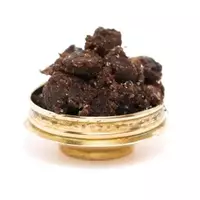Tamarind paste

Tamarind pasta is considered a well-known and widely used Asian seasoning, without which it is not possible to cook some national dishes of a number of states in the Southeast Asian region. Tamarind paste is a thick and soft mass from the fruit of the plant. The tamarind tree grows in most of the tropical countries of Asia, in Sudan, South America, as well as in Madagascar.
It is believed that the birthplace of the tamarind tree is the African continent. From Africa, tamarind spread to Asian territory in about a thousand years BC. From that very moment, people drew attention to tamarind and began to use not only the fruits of the tree as food, but also the leaves, as well as bark, which is used mainly for the manufacture of healing infusions. Around the 16th century, the modern history of tamarind-based seasonings began.
There are two main types of seasonings involving the fruit of the plant - tamarind paste and sauce. Tamarind pasta refers to the obligatory seasonings in Thai national cuisine. Most of the first dishes in Thailand have an expressive both sour and sharp taste, as well as a distinctive aroma. Thai chefs get amazing taste combinations just thanks to tamarind pasta.
The product is not rarely used as a base for the marinade of meat and fish ingredients. tamarind pasta works beautifully with seafood dishes. Tamarind pasta is at the heart of some well-known sauce, for example, British grouchester cannot think without tamarind. In Asia, a drink is made based on tamarind paste, which is served with desserts or main dishes. Japanese people like to serve tamarind pasta as sushi and roll sauce.
In China, tamarind pasta is considered an excellent sauce for snacks such as spring rolls, shaomayam or wonton. often you can find a number of other product names. often tamarind paste is called the extract and pulp of tamarind fruits. This is essentially true, since for the industrial manufacture of tamarind paste, the fruits of the plant are ground to a homogeneous mass of dark color.
Prepared at home, tamarind pasta differs from store pasta not only in its appearance, but in its taste and aroma qualities. For the preparation of tamarind paste, only fresh fruits of the plant are used. The flesh of tamarind beans is extracted from the plant pod, then poured with boiling water. After a while, the tamarind fruits need to be wiped, and the resulting fruit mass is added a little sugar.
Tamarind paste has a rich sour taste and a fruity aroma. The beneficial properties of the plant fruits make it possible to classify tamarind paste as a healthy food. It is known that tamarind helps in the prevention and treatment of asthma, fever, malaria, as well as other infectious diseases. Tamarind paste will be a wonderful natural general strengthening agent for your body.
tamarind paste 239 kCal
Energy value of tamarind paste (Ratio of proteins, fats, carbohydrates - ju):
Proteins: 2.8 g (~ 11 kCal)
Fats: 0.6 g (~ 5 kCal)
Carbohydrates: 62.5g (~ 250kCal)
Energy ratio (bj | y): 5% | 2% | 105%
 Español
Español Français
Français Português
Português Русский
Русский 简体中文
简体中文 繁體中文
繁體中文 日本語
日本語 한국어
한국어 العربية
العربية Türkçe
Türkçe Қазақ
Қазақ Deutsch
Deutsch Italiano
Italiano Українська
Українська
